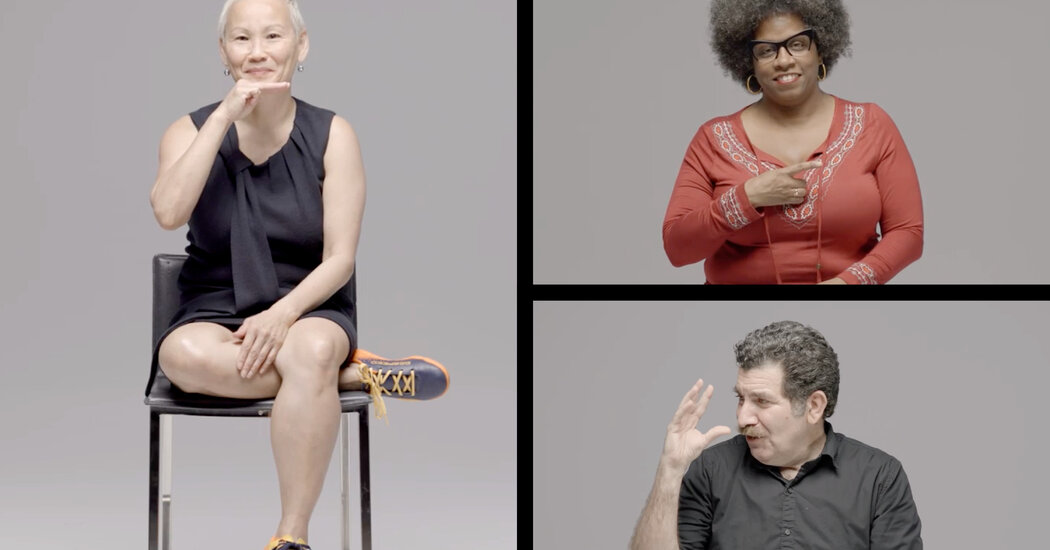
How a Question on Sign Language Led to a Deeper Look at Deaf Culture
08/30/2021By Sarah Bahr
Times Insider explains who we are and what we do, and delivers behind-the-scenes insights into how our journalism comes together.
How does a person get a name sign — the series of unique gestures used to identify someone in American Sign Language? For a team of Times journalists, the process of answering that question underscored the importance of two storytelling basics — rely on experts and think of the audience — and resulted in an interactive article in July that provided a broader understanding of deaf culture.
“One of our priorities was to show our readers the diversity of experiences and backgrounds that exist in the deaf world,” Ilaria Parogni, a senior editor who wrote the article, said. “Delving into name signs allowed us to tap into that.”
The challenge began when The Times set out to learn how Vice President Kamala Harris received her name sign (also known as a sign name).
Name signs are an important component of “capital D Deaf” culture, a term used by some deaf people to indicate that they embrace deafness as a cultural identity. The signs consist of gestures that can reflect facets of an individual’s personality, physical features or background.
A group of five women had collaborated on a name sign for Vice President Harris after agreeing that her Black and Indian heritage should inform her name.
Scott Reinhard, a graphics editor, originally pitched the idea to the Culture desk and suggested talking to the women about how they arrived at the name sign. Ms. Parogni and Alicia DeSantis, a deputy editor for visuals and multimedia, organized a two-hour video call with the five women in February. Ms. Parogni has family members who have experienced hearing loss and had previously written stories about on-screen representation of deaf and hard-of-hearing characters on television.
But, she said, “I’m always conscious that I’m not a member of the Deaf community.” So she consulted ASL teachers throughout the project, asking for advice on sensitive subjects like the best way to indicate that someone is speaking ASL in an article. She also shared insights with the team that she gained from her experiences reporting and researching the subject.
The Times worked with several interpreters throughout the project, consulting with an interpreting agency that assisted in selecting translators who would cater to the needs of people from different backgrounds. “Diversity was important to us,” Ms. Parogni said. “Behind the scenes, too.”
Ms. Parogni said that it quickly became clear to everyone that there was a much bigger story to be told beyond Ms. Harris — about the history of name signs and their significance to deaf people.
It was clear, too, that video, graphics and design would have to be integrated in order to tell the story in a fully accessible way. Overall, more than a dozen journalists worked on the project, including Deborah Leiderman, a senior editor who also was involved since the beginning. She helped produce the project and edited the written component. Ms. Leiderman also had worked with Ms. Parogni on previous articles about deaf people.
Meg Felling, an assistant video editor, edited the videos and created subtitles based on the interpreters’ translations. She did not know ASL, so she looked up signs to avoid cutting someone off in the middle of a sentence as she was making edits. Still, there were questions the team had to work through.
“Interpreting isn’t an exact science,” Ms. Parogni said. “So, for a certain word, we’d often have to go back to the source to be 100 percent sure.”
Amanda Morris, a hard-of-hearing woman raised by two deaf parents who is fluent in ASL, offered additional support when she joined The Times in June as a disability reporting fellow.
“It made a huge difference,” Ms. Parogni said. “Not just to have someone who could look at subtitles and make sure the ASL was right, but also confirm we were approaching the project in the right way.”
Ms. Morris helped make a few of the subtitles more accurate. “Signs can look very similar,” she said. “It’s important to use multiple context clues such as facial expressions and body language to figure out what a person is saying.”
The team also took her recommendation to make a key detail in the story more prominent: Name signs cannot be assigned by a hearing person. And Ms. Morris reinforced a direction team members had decided on earlier to make the article accessible to visually impaired readers by including video transcripts — invisible descriptions of videos on a page that are read aloud to blind or visually impaired users on a screen reader.
Ms. Morris said she hopes all of these efforts will help educate readers about deaf people and show “that sign language has deep cultural significance.”
What Matters in a Name Sign?
We look at the origins of name signs in deaf culture, including one recently assigned to Vice President Harris.
Source: Read Full Article


